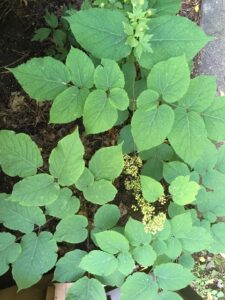NATIVES TO KNOW
American Spikenard, Aralia racemosa
By Linda Shuster, WORC Board Member-at-Large
Common names for Aralia racemosa include spikenard, American spikenard, spignet, life-of-man, and Indian root. It belongs to the ginseng (Araliaceae) family. It is, according to the University of Michigan Herbarium, one of the largest herbaceous species in our Michigan flora.
 American spikenard is found in many Michigan counties and also on several of the Great Lakes islands, including Drummond, Mackinac, Beaver, and Isle Royale. It typically lives in moist beech-maple and hemlock-hardwood forests, particularly along the edges and in clearings. Although growing as large as a shrub at heights of 3–6′, it is an herbaceous perennial that dies back each fall. The large leaves are compound and alternate with toothed edges and pointed tips. The small white flowers appear as umbels on branched panicles, which makes the inflorescence quite showy despite the small size of the flowers. Bloom time is June–August. It prefers shade to partial shade and will tolerate a range of moist to average soil types. The fruit is initially white and then turns a pretty purplish color. The purple stems of American spikenard are stout and can become almost woody. While some sources state that it is easy to grow from seed, others suggest that it is challenging. The seed must be cold stratified. It can also be propagated via rootstock. American spikenard develops a large root system, so once it is established, it will be difficult to move.
American spikenard is found in many Michigan counties and also on several of the Great Lakes islands, including Drummond, Mackinac, Beaver, and Isle Royale. It typically lives in moist beech-maple and hemlock-hardwood forests, particularly along the edges and in clearings. Although growing as large as a shrub at heights of 3–6′, it is an herbaceous perennial that dies back each fall. The large leaves are compound and alternate with toothed edges and pointed tips. The small white flowers appear as umbels on branched panicles, which makes the inflorescence quite showy despite the small size of the flowers. Bloom time is June–August. It prefers shade to partial shade and will tolerate a range of moist to average soil types. The fruit is initially white and then turns a pretty purplish color. The purple stems of American spikenard are stout and can become almost woody. While some sources state that it is easy to grow from seed, others suggest that it is challenging. The seed must be cold stratified. It can also be propagated via rootstock. American spikenard develops a large root system, so once it is established, it will be difficult to move.
 American spikenard is a host plant for a type of shield bug, Elasmostethus atricornis. Its flowers attract small bees, such as yellow-faced bees (Hylaeus spp), as well as solitary wasps. In addition, the purple berries are a magnet for birds.
American spikenard is a host plant for a type of shield bug, Elasmostethus atricornis. Its flowers attract small bees, such as yellow-faced bees (Hylaeus spp), as well as solitary wasps. In addition, the purple berries are a magnet for birds.
Although some sources state that the berries are not edible by humans, others suggest that they are edible and can be used, for example, to make jelly. Like its cousin, Aralia nudicaulis or Wild sarsaparilla, its roots have been used to make root beer. American spikenard is also used as an herbal, particularly for making tonics, both from the berries and from the roots. The Native American Ethnobotany website lists 83 different uses of Aralia racemosa by a variety of tribes, including the Potawatomi, the Ottawa, the Iroquois, and the Algonquin. Uses range from treating dermatological disorders to a kidney aid.
In summary, American spikenard is a great plant for shade. It produces pretty clusters of white flowers in the summer, and showy berries in the fall. Its impressive size provides structure in the shade garden. The flowers and berries are beneficial to wildlife, attracting bees and birds.
Sources
University of Michigan Herbarium
Friends of the Wildflower Garden: https://www.friendsofthewildflowergarden.org/pages/plants/americanspikenard.html
Flora of Wisconsin: https://wisflora.herbarium.wisc.edu/taxa/index.php?taxon=2581
Native American Ethnobotany Database: http://naeb.brit.org/
Image Sources
Linda Shuster
Kristine Paulus, CC BY 2.0 <https://creativecommons.org/licenses/by/2.0>, via Wikimedia Commons
